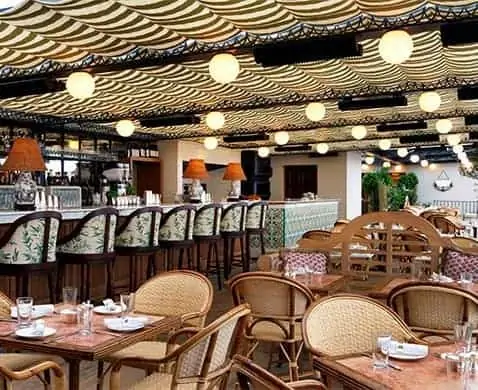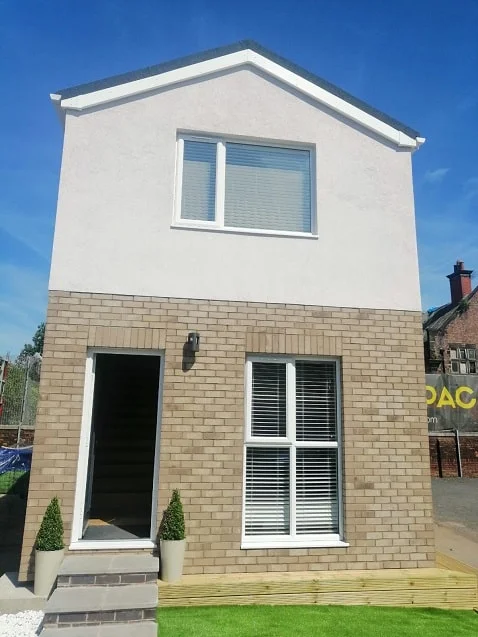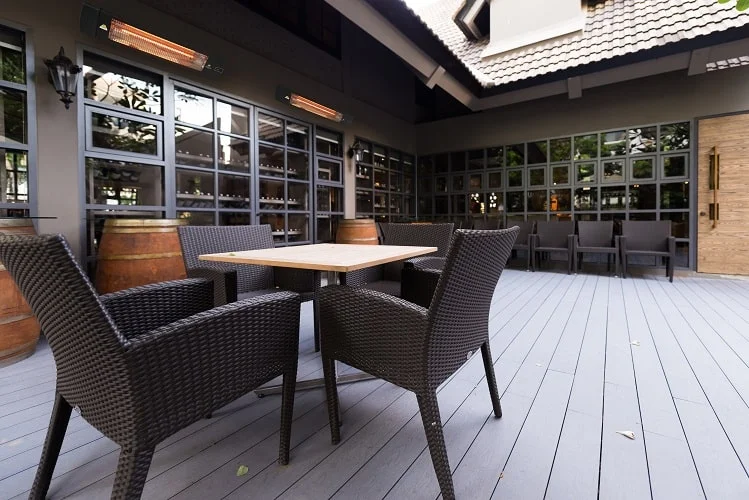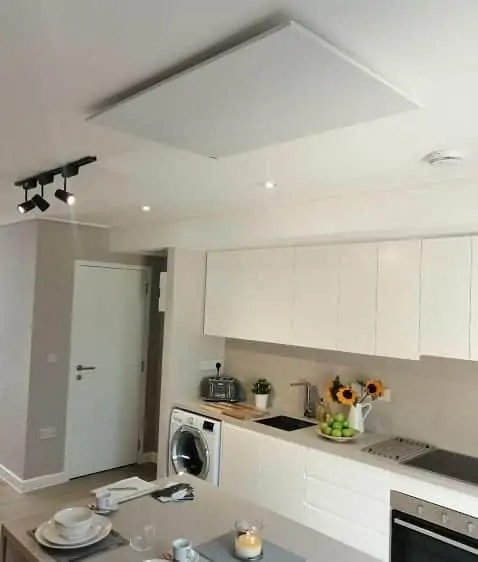No products in the basket.




Why architects choose infrared
Architects are key influencers in a building’s style, construction and materials, energy efficiency and usability.
Herschel Infrared heaters lend themselves to a building’s style and usability because they are elegant, don’t take up valuable wall or floor space and can also perform dual functions (like picture, mirror and towel heater panels). Even our Industrial Heaters are pragmatic because they are so easy to install.
Because Infrared is electric heating, it represents the future of all construction heating:
- it forms a natural partner for heat pump installations where the primary heat pump system cannot meet the overall heating requirements of a building;
- in super-insulated buildings where the heating requirement is low by design, infrared makes better investment sense than heat pumps (why invest so much in an expensive system you’ll run so little?);
- infrared works very well with Solar PV which further enhances SAP scores for electric heating;
- in smaller buildings and flats which struggle to score highly on SAP with any heating system, infrared is an ideal choice because it is easy to install, unobtrusive and long-lasting;
- many homebuilders are now turning to Infrared because it can be ceiling mounted out of the way of everything else, and is so easy to install.

Professional Specification Service
Herschel has a team of in-house surveyors who perform on-site and desktop estimating services for commercial heating projects.
Contact us with your project detailsInspiring ideas

Efficient modular housing for local authorities
Find Inspiration
Efficient modular housing for local authorities

COP26 House
Find Inspiration
COP26 House

Eco apartments
Find Inspiration
Eco apartments
Can infrared heating be integrated into the design of a building in a way that complements the overall aesthetic?
Absolutely! Herschel Infrared heaters are available in a variety of sizes and finishes and are ideal for integration into the design of a building. Our infrared panel heaters are super thin and can be installed discreetly on the ceiling or wall providing a space-saving heating solution that can also blend into the room at the same time. Some of the available finishes include White panels, Mirror, Glass, Round, Blackboard, and Picture panels, available in sizes ranging between 250W and 1250W. Our White panels can also be painted using high quality, heat resistant radiator paint to help match room aesthetics further still, the DIY SOS Interior Design team created a true style statement by painting their infrared panels to match the striking green ceiling interior. (Please note, we are unable to give any warranty around the paint itself).
We also offer the innovative Herschel Krystal, which is a compact panel heater made from microcrystal glass. Available in 600W or 1000W, in a black or white finish, the Krystal can be neatly recessed into the ceiling for a stunning, flush finish.
Our sales team will be able to help you choose the best heaters for any room or building, to book a sales consultation, click here.
Are there any specific building materials that work best with infrared heating systems?
Herschel Infrared heaters can work with almost any type of building material, although some materials are better at retaining heat and releasing more efficiently. Materials like concrete and brick have a high thermal mass, meaning they can store heat for longer durations, this helps to keep the building warmer for longer.
While building materials can make a difference, the most important factor is to take into account the levels of insulation within a building and specify accordingly. When specified correctly, infrared heating will always be effective in managing comfort levels for occupiers.
Herschel supports a fabric first approach to buildings. Any available budget that can be spent to minimise heat loss and ensure the property is able to retain heat better will result in a lower energy requirement for heating. Use our online calculator to calculate your heating requirements based on the materials and insulation in your building.
How does infrared heating impact indoor air quality, and is it a concern for building occupants?
Infrared heating positively impacts indoor air quality. Unlike traditional convectional heating systems, infrared directly heats objects, meaning it does not heat the air. Not only does this make infrared heating a much more comfortable warmth, this also means that no dust, allergens, or other pollutants are being spread around the house. Another benefit that infrared heating has on indoor air quality is the reduction of moisture, which helps to prevent mould and condensation. To find out more about how this works, click here.
How does infrared heating compare to other heating systems in terms of cost-effectiveness and energy efficiency?
Infrared heating presents an efficient form of heating as it warms up objects, people and surfaces directly rather than warming up the entire volume of air. Independent research conducted in a specially controlled chamber at Salford Energy House compared infrared heating with an air to water heat pump and direct acting electric convection heaters. The results show that outside of heat pumps, infrared is the next most efficient form of electric heating. When these efficiency results are considered alongside other costs of ownership (including purchase, install and servicing costs) Air Source heat pump costs could be 50% higher to purchase, own and run than an equivalent Herschel Infrared System. Herschel Infrared panels require no maintenance or servicing, and there is no shortage of skills required for installation (no plumbers or coolant engineers required). You can read about the Salford Energy House study here.
Infrared heating also offers room by room control with the ability to save energy by only heating the rooms in use. We have comparisons of other types of heaters compared to infrared heating here.
What is the impact of infrared heating on the environment, and how does it contribute to a building’s overall sustainability?
As a heating solution we are confident that infrared heating provides one of the most sustainable options for the built environment. There is increasing need for the population to reduce their reliance on fossil fuels and utilise low carbon, energy efficient technologies.
Herschel Infrared heating provides a future-proof heating solution that delivers lower emissions alongside improved efficiency and comfort levels for occupiers and can be coupled with renewable energy sources and battery storage. We have been chosen as the heating solution for a number of net-zero carbon emitting new homes, including the ‘COP26 House’ in Glasgow, built by Beyond Zero Homes, as well as a number of other eco builds built by housing developers. We are proud to have heated the COP26 House which achieved a 59% reduction on its whole life embodied carbon assessment versus RIBA’s ‘business as usual’ standard.
Herschel Infrared panels are solid state and present a zero maintenance, long life solution, with low embodied carbon. At Herschel, we keep sustainability at the forefront of our proposition and our infrared panel heaters are over 95% fully recyclable at end of life and our packaging is close to 100% recyclable.
Can infrared heating systems be used in outdoor spaces, such as patios or balconies, to extend the use of these areas during colder months?
Of course! Herschel Infrared offer a number of patio heating solutions, including wall-mounted, suspended, and free-standing infrared heaters, all engineered for performance, efficiency, and durability. You can find out more about our outdoor heating range here.
What is the maximum heating capacity of an infrared heating system, and can it effectively heat large or open spaces?
We can provide heating solutions for all spaces and all applications including large or open spaces. As the longest established infrared heating provider in the UK, we have specified infrared for a huge number of projects across a broad variety of residential homes and commercial applications. Our experienced team of experts can provide a specification for any project and will recommend options for heating the space, taking into account the dimensions and height alongside insulation levels.
How does the installation of infrared heating systems affect the overall construction timeline and budget?
Herschel Infrared offers very simple installation via qualified electricians, and there is no need for specialist training as is needed for the installation of heat pumps. With no requirement for additional pipework or digging up of floors, infrared can be installed incredibly quickly with minimal disruption. The COP26 House project was a timber framed building that focused on using sustainable materials and technologies. The entire build took just 8 weeks.
What is the optimal placement of infrared heating panels in a building to ensure maximum efficiency
Herschel Infrared panels can be installed on the wall or ceiling, the optimal placement of the infrared heaters depends on several factors, such as the size of the room, the layout of the building, the intended use of the room, and the type of heater being used. Our sales team will be able to help you choose the best heaters for your space and the optimal placement for these.
Some panels, such as our Glass, Blackboard, Picture, and Mirror panels cannot be installed on the ceiling, however as infrared heats people and object directly, the level of comfort will be the same regardless of whether the panels are installed on the wall or ceiling. To calculate the amount of wattage would be needed for your space, you can contact our sales team, or alternatively, can use our online calculator.



















